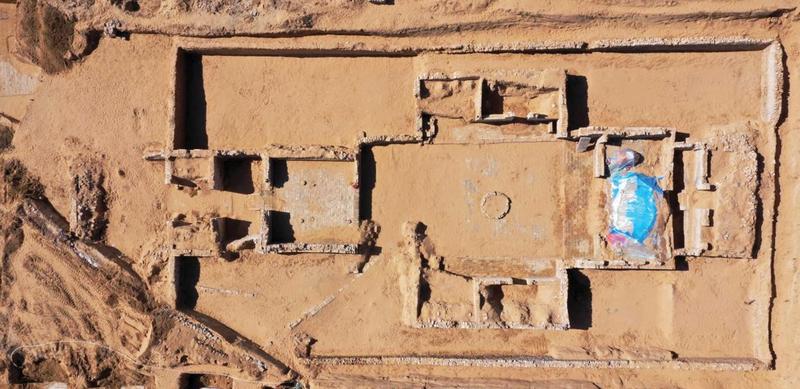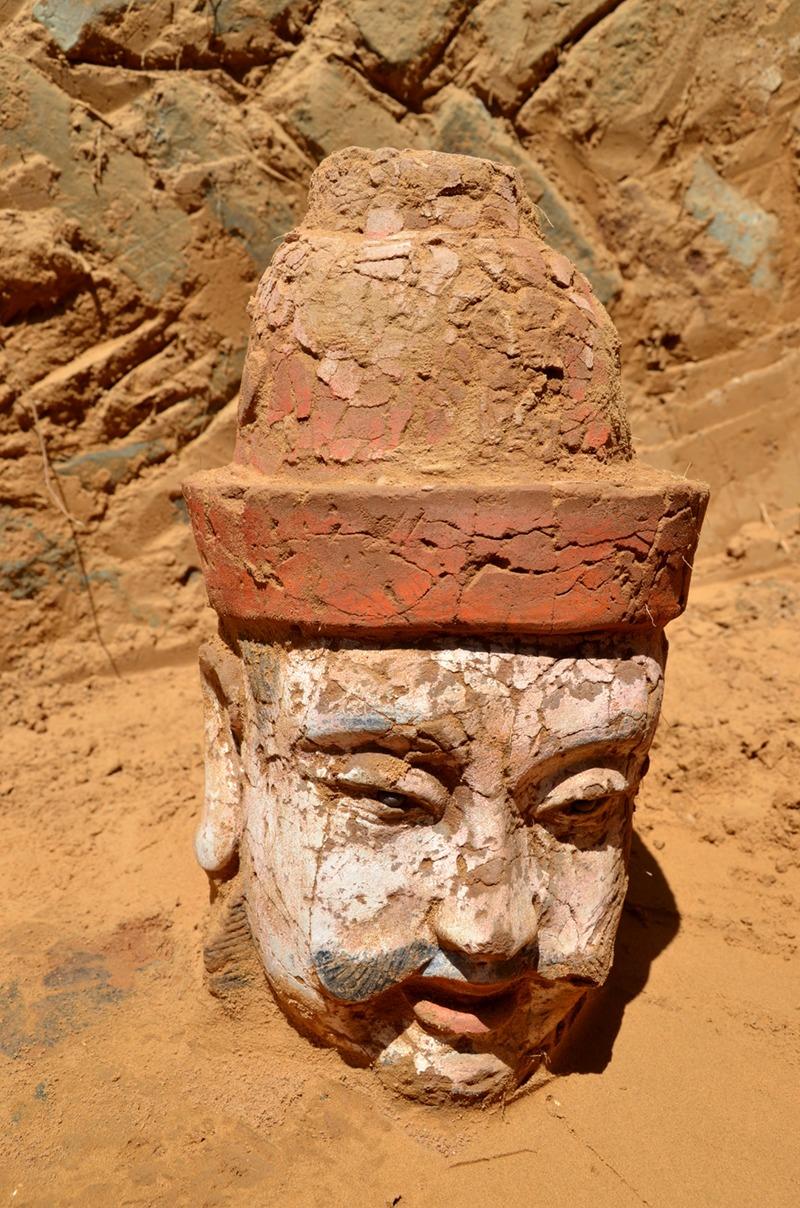 (ZHONG JINYE / FOR CHINA DAILY)
(ZHONG JINYE / FOR CHINA DAILY)
Time has taken its toll on the Jiankou section of the Great Wall in Beijing, which was constructed after emperors in the Ming Dynasty (1368-1644) issued orders for their land to be defended against nomadic people to the north.
The structure once towered over cliffs in what is now the city’s Huairou district, but over the centuries its fortified watchtowers were eroded by the weather. Water seepage and heavy vegetation also damaged the wall.
Known for its rugged beauty, Jiankou, which in Chinese translates as “arrow’s notch” — the end of an arrow that rests against the bowstring — has a reputation for being the toughest section of the Great Wall in Beijing to climb.
In 2018, a conservation project was launched in Jiankou to prevent loose parts of the wall from collapsing. For Zhang Jianwei, an archaeology professor at Peking University, this was a precious opportunity to view the structure at close quarters and delve into its history.
During the past three years, Zhang’s team has carried out archaeological investigations on an 800-meter-long section of the wall in Jiankou, including four watchtowers.
The team divided this section into 25-square-meter excavation units and has conducted detailed research in each one. Bricks and stones that have fallen from the wall are carefully cleaned and scrutinized before being returned to the structure after restoration work.
“Cultural heritage has its own life. Each renovation project over the years has been an ‘intervention’ in the wall’s life, providing crucial information,” Zhang said.
“As we have had to intervene in its life again through this ongoing project, it’s essential to first decode the information through our work as archaeologists. We can then understand how the wall’s original appearance has changed and also gain an insight into its present condition. This will greatly help with conservation work.
“We’ve basically figured out how the watchtowers were constructed, used and became damaged. This has provided key clues for our architectural studies.”
 Workers clear the Jiankou section of the Great Wall in Beijing as part of archaeological studies. (PHOTO PROVIDED TO CHINA DAILY)
Workers clear the Jiankou section of the Great Wall in Beijing as part of archaeological studies. (PHOTO PROVIDED TO CHINA DAILY)
The conservation project has also been helped by a new digital surveying platform that analyses aerial photographs of the site.
“Through digitization, conservation can be managed and evaluated with a more scientific approach. To a large extent, scattered bricks and stones that have been unearthed can be recycled for the restoration work.”
The material used to construct the wall has been retained as much as possible, and a principle of “minimum intervention” was adopted for the project, Zhang said.
Shang Heng, a researcher at the Beijing Archaeological Research Institute, said the 520-kilometer-long section of the Great Wall in Beijing passes through six districts along the Yan mountains. A small part of the structure dates to the 6th century, but most of it was built during the Ming Dynasty.
The watchtowers and lower stones were put in place in the 14th and 15th centuries, particularly during the reign of Emperor Yongle, who moved the national capital from Nanjing, in what is now Jiangsu province, to Beijing.
Reinforced brick walls were not erected on a large scale until the mid-16th century, during the reign of Emperor Jiajing. The structure’s defenses were further strengthened during the reign of Emperor Wanli (1573-1620), when the Jiankou section was built.
Zhang Zhonghua, deputy director of the Beijing institute, said, “Studying archaeology on the Great Wall is an interdisciplinary program that also involves studies of ancient architecture and the surrounding environment.
“These studies enable us to figure out the type of risks that threaten the stability and safety of the wall, helping us draft plans to prevent potential threats,” he said.
Construction of the Great Wall took more than 2,000 years, peaking from the Qin (221-206 BC) to Han (206 BC to AD 220) dynasties and later in the Ming Dynasty.
 A bird’s-eye view of the Xianying Palace temple ruins at the Qingpingbu site. (PHOTO PROVIDED TO CHINA DAILY)
A bird’s-eye view of the Xianying Palace temple ruins at the Qingpingbu site. (PHOTO PROVIDED TO CHINA DAILY)
According to the National Cultural Heritage Administration, the wall is 21,196 km long and passes through a total of 15 provincial regions. Some 8,850 km of the wall was built during the Ming Dynasty.
In January 2019, a master plan for the structure was released by the State Council, China’s Cabinet. The aim is to comprehensively guide protection, renovation, management and academic research related to the wall until 2035.
In July 2019, a national plan to establish Great Wall cultural parks was released. Since then, the National Cultural Heritage Administration has listed 83 key sections of the structure as candidates for these parks, and some 20 projects for such venues were formally approved earlier this year.
Chai Xiaoming, director of the Chinese Academy of Cultural Heritage, said: “Because the Great Wall is a cultural icon in China, most Chinese people think they’re familiar with it. Actually, we aren’t. Its specific cultural value still needs to be better explained and studied in depth.”
The Great Wall is hugely significant for Chinese. In 1933, Chinese troops fought invaders for months along the structure near Beijing during the War of Resistance Against Japanese Aggression (1931-45). As a result, the wall is often seen as a symbol of fortitude and strength.
However, because it represents the nation’s spirited resolve, people used to believe that repairs to the wall needed to be carried out in such a way that the structure appeared to have been untouched.
In the 1950s, when the Badaling section in Beijing was renovated, such an approach was adopted, but Chai now regrets that the wall’s restored appearance may not correspond precisely with how it looked originally.
In 2016, photographs of a section of the Great Wall in Liaoning province were posted online. Renovation work left the section with a totally new look, triggering anger among netizens. Although the “mistake” was later rectified, it spurred lengthy debate among the public about ways in which the Great Wall should be restored.
 The remains of a tower built on the Great Wall during the Ming Dynasty were unearthed in Yanqing district, Beijing, in 2018. (PHOTO PROVIDED TO CHINA DAILY)
The remains of a tower built on the Great Wall during the Ming Dynasty were unearthed in Yanqing district, Beijing, in 2018. (PHOTO PROVIDED TO CHINA DAILY)
Chai said: “More and more people have recognized that renovating the structure does not simply mean repairing a wall. When you add a brick or a tile, there must be a solid reference point, which can only be provided by archaeological studies.”
Archaeology, in particular, is a highlight of the plan released in 2019 to establish Great Wall cultural parks, with the aim of better retaining historical detail and supporting conservation work.
Many sections of the structure are in a poor state of repair. Unlike the fortifications on the outskirts of Beijing, which are made from bricks, on other parts of the wall, stone fences or rammed earthen walls are more in evidence.
Chai said: “Seeing the wall from an archaeological perspective, people will better understand its diversity and also accept that some parts are already in ruins. The work in Jiankou is not on a large scale, but it sets an example for more sections to follow.”
Not all archaeologists are as fortunate as those working in Jiankou.
Chai said the Great Wall is strictly protected by national laws, so scholars do not have that many chances to physically remove bricks or earth samples for their studies.
“Great Wall archaeology is not only about a wall,” he said. “There is much more cultural heritage relating to the wall than we initially thought. Our knowledge of the structure needs to be largely expanded from below ground.”
Archaeologists are particularly interested in a 10-km section of the wall built during the Ming Dynasty in Jingbian county, northern Shaanxi province. The section is home to the Qingpingbu site, a castle ruin buried in sand.
Yu Chunlei, a researcher at the Shaanxi Institute for the Preservation of Cultural Heritage and Archaeology, said Qingpingbu was constructed in the mid-15th century. In the 1690s, an army led by Emperor Kangxi during the Qing Dynasty (1644-1911) marched past the castle, heading to war north of the Great Wall. The site was gradually abandoned following the emperor’s victory.
City gates, bridges and the castle’s watchtowers have been found by Yu’s team, which since May last year has also worked on a Taoist temple ruin, known as Xianying Palace. The ruin, which is some 60 meters long and 25 meters wide, is considered by Yu to be a highlight of the ongoing project.
 A roof decoration excavated from the Qingpingbu site in Shaanxi province. (PHOTO PROVIDED TO CHINA DAILY)
A roof decoration excavated from the Qingpingbu site in Shaanxi province. (PHOTO PROVIDED TO CHINA DAILY)
Studies of inscriptions on a stone tablet unearthed at the temple, which dates to the reign of Emperor Wanli, show the site was devoted to a local patron god. About 30 colorful earthen lifesize statues were found in the temple ruins.
Yu said: “The basic layout of this courtyard is well-preserved and the statues are exquisite. The site, which was quickly buried by sand after being abandoned, has seldom been disturbed by human activities, helping to protect its original condition.”
To the east of the temple, another structure, which is more than
3 meters high, is still buried by sand, giving Yu further hopes for follow-up excavation work.
Records show that 36 castles in the area were used as barracks for soldiers safeguarding the northern frontier along the wall.
Yu said the temple was built on this site to show that the Ming government was determined to safeguard the frontier.
Numerous porcelain pieces unearthed at the site are evidence that the castle was situated on a regular trade route. There were also two markets near the fortification.
Yu said: “As a result of booming trade, there was frequent communication among different cultures and ethnic groups in this area. The Great Wall thus became a crossroads where agrarian culture to the south and nomadic culture to the north mixed, forming a shared community of Chinese civilization.”
Studies of other heritage sites along the Great Wall have also produced a better insight into its history.
In 2019, archaeologists from the Institute of Cultural Relics and Archaeology of Inner Mongolia and from Sun Yat-sen University in Guangzhou, Guangdong province, began researching a city ruin from the Han Dynasty near Hohhot, capital of the Inner Mongolia autonomous region.
 A statue excavated from the Qingpingbu site. (PHOTO / XINHUA)
A statue excavated from the Qingpingbu site. (PHOTO / XINHUA)
Zhang Wenping, a researcher from the Inner Mongolia institute, said that although the ruin — known as the Shaliangzi site — was only the size of a basic county seat in those times, the remains of earthen architecture, covering about 1,800 square meters, are evidence of its exceptional status.
“Tiles unearthed at the site were even found to have a similar pattern to those excavated from the ruins of Han Dynasty imperial palaces,” Zhang Wenping said.
The remains of cellars and pottery-throwing gauges, along with a large amount of millet, have been found at the site, showing it was used as a barn, the researcher said.
As people in the county seat may not have needed such a big barn, archaeologists now widely believe the site was used to house soldiers guarding the Great Wall.
“As a frontier city close to the wall during the Han Dynasty, it helps us fill the gaps in our archaeological studies of such heritage,” Zhang Wenping said. “It’s also the first time that we have found a Han barn along the Great Wall.”
As management of the barn was strictly controlled by the central government to ensure food supplies, he expects further research to assist comprehensive studies of the national political and economic systems during the Han Dynasty, which governed the northern frontier area.
In the middle of the 1st century BC, Huhanye, a leader of the nomadic Xiongnu people, moved south to pledge allegiance to the Han Dynasty and join efforts to safeguard the border.
Records show there were no warning signals on the northern frontier for generations and that the people lived prosperous lives.
“The barn is probably an indicator of those peaceful and flourishing times,” Zhang Wenping added.
Wei Jian, a professor of archaeology and museology at Renmin University of China, said, “The Great Wall was built as a military defense system, but nomadic people continued to move south throughout ancient history, seeking to establish their new homes in Central China.
“The wall thus became a driving force for cultural exchanges that maintained the country’s vitality and growth.”


